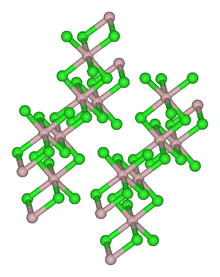Yttrium(III) chloride
 | |
| Names | |
|---|---|
| IUPAC names
Yttrium(III) chloride Yttrium trichloride | |
| Identifiers | |
3D model (JSmol) |
|
| ChemSpider | |
| ECHA InfoCard | 100.030.716 |
| RTECS number | ZG3150000 |
| |
| |
| Properties | |
| YCl3 | |
| Molar mass | 195.26 g/mol |
| Appearance | white solid |
| Density | 2.67 g/cm3 |
| Melting point | 721 °C (1,330 °F; 994 K) |
| Boiling point | 1,507 °C (2,745 °F; 1,780 K)[1] |
| 82 g/100 mL | |
| Solubility | 60.1 g/100 mL ethanol (15 °C) 60.6 g/100 mL pyridine (15 °C)[2] |
| Structure | |
| Monoclinic, mS16 | |
| C12/m1, No. 12 | |
| Hazards | |
| Flash point | Non-flammable |
| Related compounds | |
Other anions |
Yttrium(III) fluoride Yttrium(III) bromide Yttrium(III) iodide |
Other cations |
Scandium(III) chloride Lanthanum(III) chloride Actinium(III) chloride |
Except where otherwise noted, data are given for materials in their standard state (at 25 °C [77 °F], 100 kPa). | |
| Infobox references | |
Yttrium(III) chloride is an inorganic compound of yttrium and chloride. It exists in two forms, the hydrate (YCl3(H2O)6) and an anhydrous form (YCl3). Both are colourless solids that are highly soluble in water and deliquescent.
Structure
Solid YCl3 adopts a cubic structure with close-packed chloride ions and yttrium ions filling one third of the octahedral holes and the resulting YCl6 octahedra sharing three edges with adjacent octahedra, giving it a layered structure.[3] This structure is shared by a range of compounds, notably AlCl3.
Preparation and reactions
YCl3 is often prepared by the "ammonium chloride route," starting from either Y2O3 or hydrated chloride or oxychloride.[4][5] or YCl3·6H2O.[6] These methods produce (NH4)2[YCl5]:
- 10 NH4Cl + Y2O3 → 2 (NH4)2[YCl5] + 6 NH3 + 3 H2O
- YCl3·6H2O + 2 NH4Cl → (NH4)2[YCl5] + 6 H2O
The pentachloride decomposes thermally according to the following equation:
- (NH4)2[YCl5] → 2 NH4Cl + YCl3
The thermolysis reaction proceeds via the intermediacy of (NH4)[Y2Cl7].
Treating Y2O3 with aqueous HCl produces the hydrated chloride (YCl3·6H2O). When heated, this salt yields yttrium oxychloride rather than reverting to the anhydrous form.
References
- ↑ Yttrium & Compounds, United States Occupational Safety and Health Administration, 2007-01-11, retrieved 2008-05-29
- ↑ Spencer, James F. (1919), The Metals of the Rare Earths, New York: Longmans, Green, and Co, p. 135, retrieved 2008-05-29
- ↑ Wells A.F. (1984) Structural Inorganic Chemistry 5th edition Oxford Science Publications ISBN 0-19-855370-6
- ↑ Meyer, G. (1989). "The Ammonium Chloride Route to Anhydrous Rare Earth Chlorides-The Example of YCl3". Inorganic Syntheses. 25: 146–150. doi:10.1002/9780470132562.ch35. ISBN 978-0-470-13256-2.
- ↑ Edelmann, F. T.; Poremba, P. (1997). Herrmann, W. A., ed. Synthetic Methods of Organometallic and Inorganic Chemistry. VI. Stuttgart: Georg Thieme Verlag. ISBN 3-13-103021-6.
- ↑ Taylor, M.D.; Carter, C.P. "Preparation of anhydrous lanthanide halides, especially iodides". Journal of Inorganic and Nuclear Chemistry. 24 (4): 387–391. doi:10.1016/0022-1902(62)80034-7.